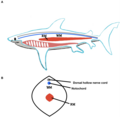Portal:Sharks
Welcome to the shark portal

Sharks are a group of elasmobranch fish characterized by a cartilaginous skeleton, five to seven gill slits on the sides of the head, and pectoral fins that are not fused to the head. Modern sharks are classified within the clade Selachimorpha (or Selachii) and are the sister group to the Batoidea (rays and kin). Some sources extend the term "shark" as an informal category including extinct members of Chondrichthyes (cartilaginous fish) with a shark-like morphology, such as hybodonts. Shark-like chondrichthyans such as Cladoselache and Doliodus first appeared in the Devonian Period (419–359 million years), though some fossilized chondrichthyan-like scales are as old as the Late Ordovician (458–444 million years ago). The oldest confirmed modern sharks (selachimorphs) are known from the Early Jurassic, about 200 million years ago, though records of true sharks may extend back as far as the Permian.
Sharks range in size from the small dwarf lanternshark (Etmopterus perryi), a deep sea species that is only 17 centimetres (6.7 in) in length, to the whale shark (Rhincodon typus), the largest fish in the world, which reaches approximately 12 metres (40 ft) in length. They are found in all seas and are common to depths up to 2,000 metres (6,600 ft). They generally do not live in freshwater, although there are a few known exceptions, such as the bull shark and the river shark, which can be found in both seawater and freshwater. Sharks have a covering of dermal denticles that protects their skin from damage and parasites in addition to improving their fluid dynamics. They have numerous sets of replaceable teeth.
Several species are apex predators, which are organisms that are at the top of their food chain. Select examples include the tiger shark, blue shark, great white shark, mako shark, thresher shark, and hammerhead shark. (Full article...)
Selected article -
An ambush predator, Pacific angelsharks conceal themselves on the sea floor and wait for approaching prey, primarily bony fishes and squid. Prey are targeted visually and, with a quick upward thrust of the head, snatched in protrusible jaws. Individual sharks actively choose ideal ambush sites, where they remain for several days before moving on to a new one. This species is more active at night than during the day, when it stays buried in sediment and seldom moves. Reproduction is ovoviviparous, meaning that the embryos hatch inside the mother's uterus and are sustained by a yolk sac until birth. Females give birth to an average of six young every spring.
Pacific angelsharks are not dangerous to humans unless provoked, in which case their bite can cause a painful injury. They are valued for their meat and are captured by commercial and recreational fishers across their range. A targeted gillnet fishery for this species began off Santa Barbara, California in 1976 and ended in 1994, after overfishing and new regulations led to its near-collapse. This species is now mainly fished in Mexican waters. The World Conservation Union has assessed this species as Near Threatened, as the Californian population is largely protected and recovering, while the impact of Mexican fisheries is unknown.
Did you know (auto-generated)

- ... that Timo Meier became the first player in San Jose Sharks franchise history to score five goals in one game when he was 25?
- ... that "the Hurricane Shark is real"?
- ... that Hixxy and Sharkey created a schism in the UK rave music scene in 1995?
- ... that the ampullae of Lorenzini enable sharks to sense electric fields?
- ... that since 2018, IKEA's stuffed toy shark Blåhaj has become a popular Internet meme and an icon of the online transgender community?
- ... that Alexis Sharkey's last Instagram post before her murder documented her travels to Tulum, Mexico?
Categories
Related portals
WikiProjects
Selected picture -

More Did you know? -
- ... that when captured, the tawny nurse shark often spits a jet of water into the faces of its captors?
- ... that the swellshark bends its body in a U-shape and sucks in water to double in size and avoid attacks from predators?
- ...that shark threat display is an exaggerated swimming style exhibited by some sharks when they perceive they are in danger?
- ... that almost a quarter of the brown lanternsharks found in Suruga Bay, Japan, have both male and female organs?
- ... that the blacktip shark can reproduce asexually?
General images
Topics
For additional lists of marine life-related featured articles and good articles see:
Wikimedia
The following Wikimedia Foundation sister projects provide more on this subject:
-
Commons
Free media repository -
Wikibooks
Free textbooks and manuals -
Wikidata
Free knowledge base -
Wikinews
Free-content news -
Wikiquote
Collection of quotations -
Wikisource
Free-content library -
Wikispecies
Directory of species -
Wikiversity
Free learning tools -
Wiktionary
Dictionary and thesaurus















































